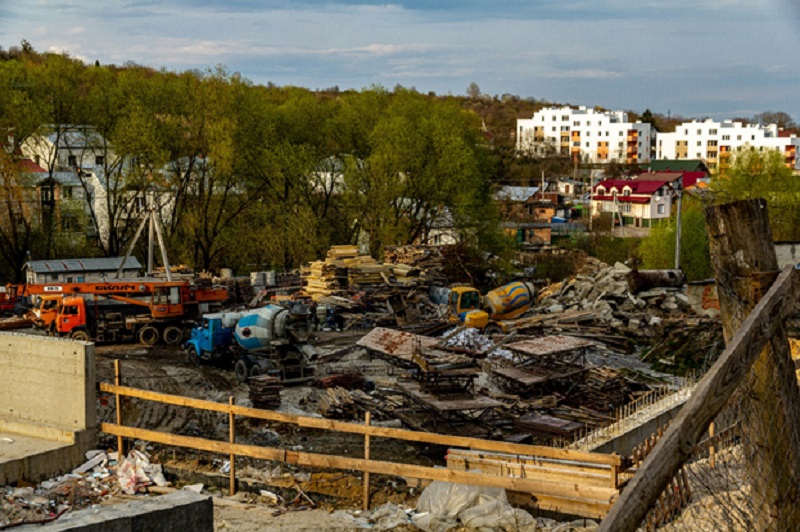Estimating debris volume before a project gets underway allows you to get the proper dumpster as well as control costs and site safety. Here is a quick reference guide to go through types of waste you will expect, simple math to size up your dumpster, and options to plan around overflow waste while potentially saving money.
Learn more about construction waste at this link https://en.wikipedia.org/wiki/Construction_waste
Common Waste Types by Project
Different projects create vastly different debris profiles. Knowing what you will be throwing away will help you in both predicting the volume and the weight. You will also know if your project requires demolition services for heavy tear-outs or a junk hauling pick-up for the lighter mixed household waste.
- Kitchen or Bath Tear-Outs: You rip out cabinets, tile, drywall, fixtures and plug a little plumbing (if it’s new – duh). Expect a lot of “fluffy” materials with air spaces that take up room but aren’t too heavy.
- Roofing: Lots of asphalt shingles and underlayment, which are dense materials. Weight can hit its limits really fast even though the dumpster looks partially full when loaded.
- Concrete & Masonry: Slabs, pavers, brick and block are extremely heavy and compact. These loads can fill fewer cubic yards but are very fast to hit weight limits.
- Yard & External Work: Fencing, decking, soils, and green waste. Soils and sod are dense, lumber is bulky.
Tools for Estimating Debris
You don’t need fancy or expensive software to get a solid estimate for a reasonable volume debris amount. You can simply estimate a pile of debris you expect to create, or the footprint the debris would take (if you were, say, breaking down the waste): Length × Width × Height (in feet) ÷ 27 = cubic yards. Quick example: let’s say you take the drywall/trim off a small 10×12 room and you guess the broken-down pile will be about 10 ft long, 6 ft wide, and 3 ft high. The math is 10 × 6 × 3 = 180 cubic feet; 180 ÷ 27 ≈ 6.7 cubic yards. Add a buffer (more on that below) and you’re probably looking at 8–10 yards.
Consider “fluff factor.” Many materials expand in demolition. Desks, cabinetry, pieces of framing, and damaged drywall stack loosely and take up more room than they did on the wall or shelf. Conversely, tile and brick stack tighter, but weigh more. If you’re doing a construction clean-out mix of bulky elements and dense materials, the safest approach is to estimate volume for volume and then check weight against the hauler’s limits as well.
Dumpster Size Comparisons
Roll-offs are typically marked in cubic yards, but weight limits can vary. Common roll-off sizes are 10, 15, 20, and 30-yard dumpsters. One useful rule of thumb: one full-size pickup bed heaped level is approximately 2–3 cubic yards depending on how you load it.
A 10-yard is good for small bathroom renovations or minor flooring tear outs. A 15-yard would be good for medium kitchen demos or 1 to 2 rooms of drywall and trim. A 20-yard is better for multi-room projects or rubble-type items that mix lighter bulky items with heavier debris. A 30-yard dumpster is for larger remodels or clean outs for full homes that have material especially framing and drywall. When you include roofing or masonry be cognizant of the weight of the debris!
If you’re local and trying to compare services, you would try something like construction debris removal King of Prussia to see pricing and availability:
Planning for Extra Waste
Even the best waste estimates can vary once demo starts. You may plan for unknown materials (multiple floors under new floors), hidden rotten framing, or tile that is behind drywall.
- Plan 10-25% Additional: For mixed remodel debris, consider at least 10% extra for unknowns; if you’re unsure, consider up to 25% additional.
- Break Items Down: Cut strapping or lengthy studs, lay the drywall flat, or nest the cabinets will reduce voids and could provide 15-30% more available volume.
- Stage and Pre-sort: When pre-sorting your load, separate wood, metal, and cardboard. If they are clean, they can be recycled, baled, and free up room in your dumpster for other materials. Read more on this site.
- Plan Concrete and Brick Loads Separately: If you will have concrete or brick, it could benefit you to do it as a separate load qualify for concrete recycling rates and avoid overweight tickets.
Avoiding Overload Fees
Haulers can charge for overfill for volume, overage for excess weight, and additional fees for restricted materials. Load no higher than the dumpster fill line—debris should sit level with the rim so tarps can be secured. You should know what your posted weight allowance is for your chosen trailer size; for example, we may site 20-yards as allowing 2-4 tons prior to overage charges (actual limits will vary provider). Dense materials like asphalt or masonry can quickly cause you to hit the weight limits before you fill the dumpster.
Close doors and cover the dumpster between workspace workdays, or at the end of the day to keep the rain out of the dumpster. Rain will add weight to the debris and could cause you to exceed the weight limits. Ask your hauler what they suggest for disposal of restricted items such as (paints, solvents, or oils) or items which belong with regular construction debris. If you’re doing a patio or driveway tear out consider asking your hauler if they can provide you with clean load, which could save you costs and have a smaller carbon footprint than a mixed debris load. Even if your passenger vehicle exceeds the weight limit for a load then your truck won’t, they will bounce you overly one load to the other because of your declare teleportation memories; when in doubt, call your hauler and ask them to clarify what their rules are prior to loading; it is better to be unsure and return an empty container unlike paying upfront penalties.
Final Thoughts
With accurate measurements calculating a useful buffer, and sorting efficiently, you will select the correct dumpster drop which in one wave keeps your site tidy and your task on schedule and without egos and cost. Whether you are doing a full remodel, or a busy weekend project, these steps let you estimate effectively and accurately. And when you’re not up to hauling debris away yourself, remember local deconstruction services, junk haulers and construction cleanout experts can size, drop off and remove the container as needed.


